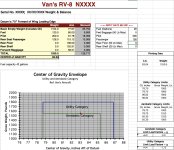BLUF: Has anyone seen this +5g limit (Kevin Hortons POH), should it be followed? Can the MAW and MTOW be a linear relationship?
Morning All,
Im new to the Vans Air Force buying into an 1998 RV-8. Never thought the RV Grin was real until I flew her solo for the first time.
Im looking to get back into some aerobatic flying. Ive already started by revising the basics (loops, rolls, tail slides), but have found that unless I take no fuel I cant share these expirineces with family and friends in the back.
Looking into this, Ive found that Kevin Hortons POH (awesome document, well laid out) mentions a +5g limit? I cant find this anywhere else and would like some more context behind it if there is some?
chrome-extension://efaidnbmnnnibpcajpcglclefindmkaj/https://www.ninelima.org/poh/Vans/RV-8A/RV8-poh-2011-kevin-horton.pdf
Else, can I extrapolate a linear plot between the weight and g-load limits on the aircraft?
Ex: +6g at 725kg and +3.3g at 816kg? Can a pick a point inbetween and say that I can pull +4g at 780kg?
Or should I treat the weights and g's like a cliff, where 726kg-816kg are a +3.3g limit.
Looking forward to hearing your comments on the above,
Safe flying!
Morning All,
Im new to the Vans Air Force buying into an 1998 RV-8. Never thought the RV Grin was real until I flew her solo for the first time.
Im looking to get back into some aerobatic flying. Ive already started by revising the basics (loops, rolls, tail slides), but have found that unless I take no fuel I cant share these expirineces with family and friends in the back.
Looking into this, Ive found that Kevin Hortons POH (awesome document, well laid out) mentions a +5g limit? I cant find this anywhere else and would like some more context behind it if there is some?
chrome-extension://efaidnbmnnnibpcajpcglclefindmkaj/https://www.ninelima.org/poh/Vans/RV-8A/RV8-poh-2011-kevin-horton.pdf
Else, can I extrapolate a linear plot between the weight and g-load limits on the aircraft?
Ex: +6g at 725kg and +3.3g at 816kg? Can a pick a point inbetween and say that I can pull +4g at 780kg?
Or should I treat the weights and g's like a cliff, where 726kg-816kg are a +3.3g limit.
Looking forward to hearing your comments on the above,
Safe flying!





